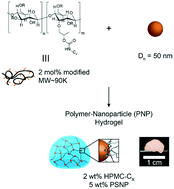当前位置:
X-MOL 学术
›
Mol. Syst. Des. Eng.
›
论文详情
Our official English website, www.x-mol.net, welcomes your
feedback! (Note: you will need to create a separate account there.)
Structural considerations for physical hydrogels based on polymer–nanoparticle interactions
Molecular Systems Design & Engineering ( IF 3.2 ) Pub Date : 2020/01/09 , DOI: 10.1039/c9me00120d Anthony C. Yu 1, 2, 3, 4 , Anton A. A. Smith 1, 2, 3, 4 , Eric A. Appel 1, 2, 3, 4
Molecular Systems Design & Engineering ( IF 3.2 ) Pub Date : 2020/01/09 , DOI: 10.1039/c9me00120d Anthony C. Yu 1, 2, 3, 4 , Anton A. A. Smith 1, 2, 3, 4 , Eric A. Appel 1, 2, 3, 4
Affiliation

|
Designing supramolecular hydrogels for complex translational applications requires the ability to engineer viscoelasticity and flow behaviour at the bulk scale as well as the network structure at the nano and micro scales. Here we examine supramolecular hydrogels formed by polymer–nanoparticle interactions between hydrophobically-modified biopolymers and polymeric nanoparticles. Crosslinking in these systems is driven by dynamic and multivalent interactions between the biopolymers and the nanoparticles. We demonstrate control over viscoelasticity and microstructure by altering the hydrophobicity of pendant groups along the polymer backbone. Increasing the pendant group hydrophobicity creates larger polymer corona heights and, once a critical interparticle distance is spanned, induces a jammed microstructure that reinforces bridging based crosslinking. These studies suggest that design considerations for polymer–nanoparticle hydrogels are analogous to those of jammed soft glasses and provide an engineering handle to tune microstructure and viscoelasticity through chemical modifications to the polymer backbone. These materials are expected to be useful for applications that require injection, spraying, and control over cargo release kinetics.
中文翻译:

基于聚合物-纳米粒子相互作用的物理水凝胶的结构考虑
设计用于复杂平移应用的超分子水凝胶需要具有在整体规模上工程化粘弹性和流动性能以及在纳米和微米级网络结构的能力。在这里,我们研究了由疏水改性的生物聚合物和聚合物纳米颗粒之间的聚合物-纳米颗粒相互作用形成的超分子水凝胶。这些系统中的交联是由生物聚合物和纳米颗粒之间的动态和多价相互作用驱动的。我们通过改变沿聚合物主链的侧基的疏水性证明了对粘弹性和微观结构的控制。增加侧基疏水性会产生更大的聚合物电晕高度,并且一旦跨过临界的粒子间距离,诱导了堵塞的微结构,从而增强了基于桥接的交联。这些研究表明,聚合物纳米颗粒水凝胶的设计考虑因素类似于堵塞的软玻璃,并提供了通过化学修饰聚合物主链来调节微观结构和粘弹性的工程方法。预计这些材料可用于需要注入,喷涂和控制货物释放动力学的应用中。
更新日期:2020-02-13
中文翻译:

基于聚合物-纳米粒子相互作用的物理水凝胶的结构考虑
设计用于复杂平移应用的超分子水凝胶需要具有在整体规模上工程化粘弹性和流动性能以及在纳米和微米级网络结构的能力。在这里,我们研究了由疏水改性的生物聚合物和聚合物纳米颗粒之间的聚合物-纳米颗粒相互作用形成的超分子水凝胶。这些系统中的交联是由生物聚合物和纳米颗粒之间的动态和多价相互作用驱动的。我们通过改变沿聚合物主链的侧基的疏水性证明了对粘弹性和微观结构的控制。增加侧基疏水性会产生更大的聚合物电晕高度,并且一旦跨过临界的粒子间距离,诱导了堵塞的微结构,从而增强了基于桥接的交联。这些研究表明,聚合物纳米颗粒水凝胶的设计考虑因素类似于堵塞的软玻璃,并提供了通过化学修饰聚合物主链来调节微观结构和粘弹性的工程方法。预计这些材料可用于需要注入,喷涂和控制货物释放动力学的应用中。









































 京公网安备 11010802027423号
京公网安备 11010802027423号